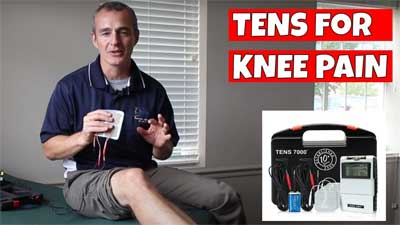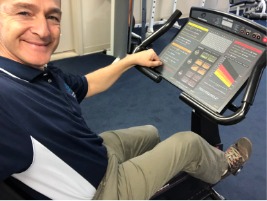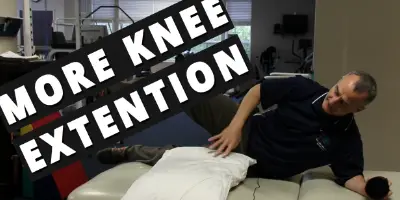Sleeping After Knee Replacement – 3 Best Positions
Finding a comfortable sleeping position after a knee replacement can be challenging. The most common advice is to sleep flat on your back with your surgical knee straight and elevated above your heart.
To achieve this, many surgeons recommend propping a pillow under your heel or using a straight wedge pillow under the surgical leg. But what about those of you who can’t sleep on your back due to other medical conditions?
What should you do?
1. Sleeping on your back
Why is sleeping on your back the most common recommendation?
Pros:
🟢 Sleeping on your back allows you to position your surgical knee in full extension.
🟢 It also enables you to elevate the surgical leg above the level of your heart to reduce swelling.
Cons:
🔴 Many individuals who have undergone a total knee replacement also suffer from low back pain associated with spinal stenosis and are unable to sleep flat on their back.
🔴 Neck pain is a common complaint for those who aren’t used to sleeping flat on their back.
Recommendations:
If your knee range of motion is improving along expected guidelines and you’re not experiencing significant swelling, consider sleeping in any position that is most comfortable for you.
2. Is it safe to sleep on my side after knee replacement?
Yes, side sleeping positions are safe and sometimes recommended after knee replacement surgery. If your knee range of motion is within the expected normal degrees based on the time since surgery, then you are encouraged to sleep in any position that provides you the best restorative sleep.
Two side sleeping positions:
- With your surgical knee down on the mattress. In this position, the bed contours to your leg. Try to keep your knee straight while sleeping on this side.
- With your surgical knee on top. In this position, you may use pillows to support the surgical leg and keep your knee above the level of your hip. This position makes it harder to keep the knee fully extended, but if your knee range of motion is within normal limits, your goal is simply to sleep well.
3. Is it safe to sleep on my stomach after knee replacement?
Yes, sleeping on your stomach, also known as prone, is both safe and an effective way to improve knee extension. The primary difference between sleeping on your stomach versus sleeping on your back with your leg propped is that the prone position will not reduce swelling. If you’ve always slept on your stomach or partially turned toward your stomach, you should be fine to return to that sleeping position.
Some patients may be concerned about the incision. If you experience significant sensitivity over the incision, there are strategies to reduce this sensitivity, but any danger in allowing the knee to rest incision down on the mattress.
Where do you put a pillow after knee surgery?
When sleeping in the supine (on your back) position, place one to three pillows under your surgical leg while attempting to keep your knee straight.
In the video below, you can see how to arrange pillows under the surgical leg to reduce swelling and position the knee comfortably:
You may also choose to use a wedge pillow if it is easier. You can find a great selection of wedge pillows on Amazon by clicking this link.
Frequently Asked Questions
-
How long should I keep my leg elevated after knee replacement surgery?
It is generally recommended to elevate your surgical leg above the level of your heart for the first few days after surgery, especially when you’re resting or sleeping. Gradually decrease the elevation as your swelling and pain decrease. It’s important to follow your surgeon’s and physical therapist’s recommendations for your specific case.
-
When can I start sleeping without a pillow under my surgical leg?
As your knee range of motion improves and the swelling decreases, you may start to feel more comfortable sleeping without a pillow under your leg. It’s essential to listen to your body and follow the guidance of your surgeon and physical therapist, who can provide personalized advice based on your recovery progress.
-
Can I use a recliner for sleeping after knee replacement surgery?
Using a recliner for sleeping after knee replacement surgery can be a good option for some individuals, as it allows for easy elevation and support of the surgical leg. However, it’s important to ensure that your knee is still in a comfortable, extended position while using a recliner. Consult with your surgeon or physical therapist for recommendations tailored to your specific situation.
About the Author -
Anthony Maritato, PT has been a licensed physical therapist since 2006. He specializes in post surgical care and rehabilitation of total knee replacement and rotator cuff repair surgery.
Mr. Maritato is also nationally recognized as a therapist educator teaching courses related to Medicare reimbursement, contracting, and documentation.
Total Therapy Solutions LLC is Tony's primary practice which he owns with his wife Kathy who is also a licensed physical therapist.
More Blog Posts …

Can you use a TENS unit after knee replacement?
A TENS unit is safe to use after a total knee replacement. It is commonly used during knee flexion and extension exercises. Using TENS to reduce pain during knee replacement exercises may improve range of motion without the need for more medication.

How To Stretch A Stiff Knee After Knee Replacement
Stretching a stiff knee at home requires patience and time. Research suggests a long duration low intensity stretch will produce the greatest benefits in knee range of motion. In this post I will discuss using a Joint Active Systems and static progressive stretch technique to improve knee flexion at home.

Knee Replacement Bending Flexion Exercises at Home
Knee bend, also known as knee flexion, exercises may be performed immediately following knee replacement surgery. This videos shows several examples of knee flexion exercises to be performed at home. 120 degrees of knee flexion is considered normal range of motion following surgery.

Can I Run After Knee Replacement
Conventional advice is to avoid high impact activities after a total knee replacement. This would include running, jogging, and other high impact sports. The concern is the increased wear and tear on the new knee will cause it to wear out sooner or possibly even...

How soon after knee replacement can I use exercise bike?
It is commonly recommended to start using an exercise bike within the first 48-hours following a knee replacement. Standard practice in physical therapy is to begin the bike with a gentle rocking motion until the knee is capable of a completing full rotation without significant pain.

Calf Pain After Knee Replacement
Calf pain can happen for many reasons, but after surgery the most common reason is weakness, swelling, and change in activity levels. These exercises will help improve calf mobility, increase strength, and condition the calf to handle the workload associated with normal walking.
Please check with your physical therapist or doctor before performing these exercises.

Minimalist Running Shoe Review Unboxing Merrell Men’s Trail Glove 4 Runner
The Merrell Men’s Trail Glove 4 Runner has been a great show. I am updating this description today January 1, 2020. I have worn the shoe for work in the clinic as a physical therapist as well as the occasional run. It is ideal for a medium or narrow foot. I absolutely would not recommend it for a wide foot or a foot that will swell over the day.

Best Tip To Improve Knee Extension- Prone Hangs
Improve knee extension with this simple and effective exercise! Total knee replacement | ACL reconstruction | Knee Surgery

Using an Elliptical Trainer After Total Knee Replacement Surgery
Using and choosing an elliptical trainer after total knee replacement surgery or any other knee surgery can be challenging. There are so many different brands available on the market. In this video I will show you how to safely get on, off, and use the elliptical trainer whether you are using one at home, at the gym, or in your physical therapy clinic.

3 Versions of a Hip Bridge for Total Knee Replacement Therapy At Home
The hip bridge is a very common exercise following total knee replacement, but doing it correctly isn’t as common. There are three version of the hip bridge and in this video I share information about all three.
